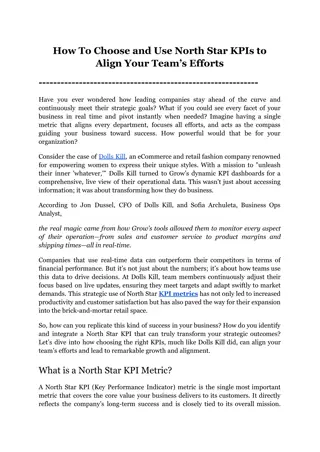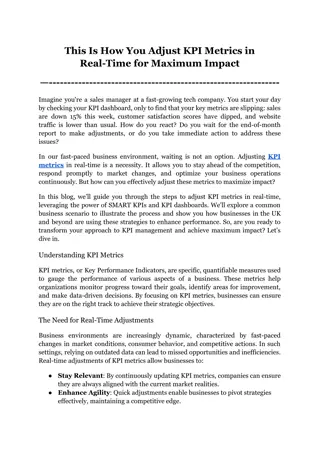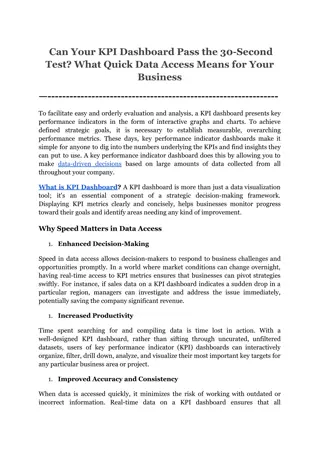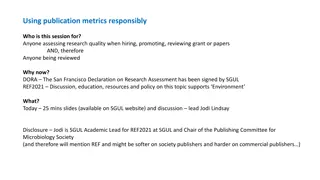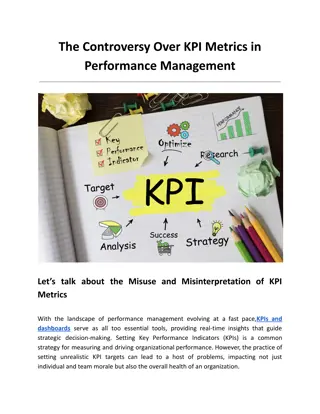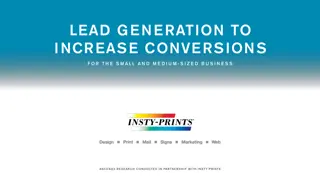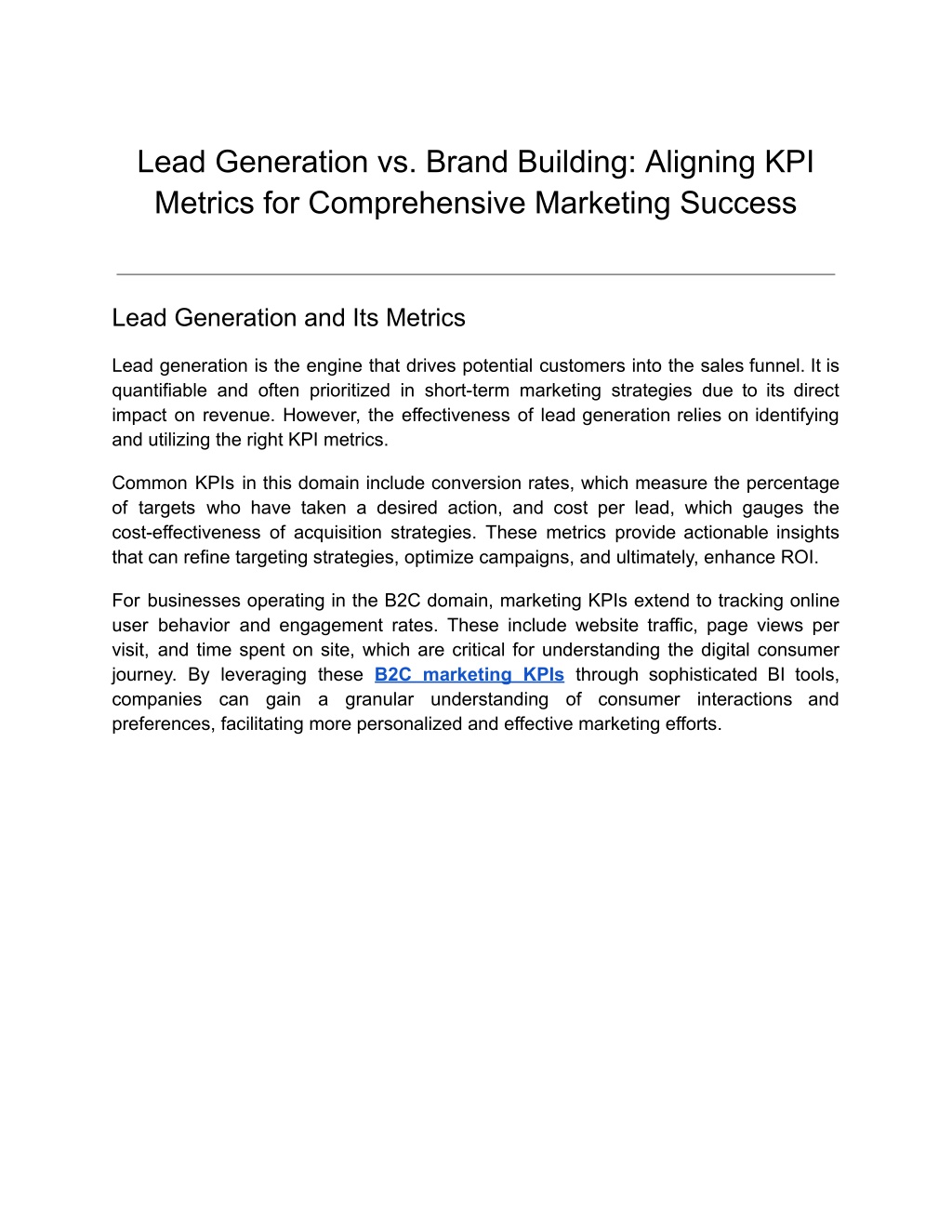
Lead Generation vs. Brand Building_ Aligning KPI Metrics for Comprehensive Marketing Success
Discover how to master the delicate balance between capturing immediate sales(lead generation) and cultivating lasting brand loyalty(brand building) by effectively aligning KPI metrics. This insightful piece delves into the dual strategies of engagin
Download Presentation

Please find below an Image/Link to download the presentation.
The content on the website is provided AS IS for your information and personal use only. It may not be sold, licensed, or shared on other websites without obtaining consent from the author. Download presentation by click this link. If you encounter any issues during the download, it is possible that the publisher has removed the file from their server.
E N D
Presentation Transcript
Lead Generation vs. Brand Building: Aligning KPI Metrics for Comprehensive Marketing Success Lead Generation and Its Metrics Lead generation is the engine that drives potential customers into the sales funnel. It is quantifiable and often prioritized in short-term marketing strategies due to its direct impact on revenue. However, the effectiveness of lead generation relies on identifying and utilizing the right KPI metrics. Common KPIs in this domain include conversion rates, which measure the percentage of targets who have taken a desired action, and cost per lead, which gauges the cost-effectiveness of acquisition strategies. These metrics provide actionable insights that can refine targeting strategies, optimize campaigns, and ultimately, enhance ROI. For businesses operating in the B2C domain, marketing KPIs extend to tracking online user behavior and engagement rates. These include website traffic, page views per visit, and time spent on site, which are critical for understanding the digital consumer journey. By leveraging these B2C marketing KPIs through sophisticated BI tools, companies can gain a granular understanding preferences, facilitating more personalized and effective marketing efforts. of consumer interactions and
Brand Building and Its Metrics Unlike lead generation, brand building is an expansive strategy aimed at establishing and nurturing long-term relationships with customers. It encompasses creating brand awareness and loyalty through consistent and meaningful engagement. The KPI metrics for brand building often focus on long-term value such as brand equity and customer lifetime value. These KPIs assess the strength of a brand s presence in the market and the long-term benefits it derives through customer retention and loyalty. Dashboard KPIs for brand building might include measures like net promoter score (NPS), which indicates customer willingness to recommend a brand to others. This is a direct reflection of brand loyalty and satisfaction. Additionally, social media engagement rates and share of voice are pivotal dashboard KPIs that help quantify brand presence and consumer perception in the digital space.
Key Performance Indicators for Lead Generation Lead generation is a fundamental aspect of a company's marketing strategy, aimed at initiating consumer interest or inquiry into products or services. In today's data-driven environment, understanding the effectiveness of these efforts is crucial. 1. Conversion Rates: The Quintessential Metric Conversion rate is the percentage of visitors who complete a desired action on a digital platform, turning from casual browsers into potential leads. This KPI is crucial as it directly correlates to the effectiveness of lead generation campaigns. High conversion rates often indicate that marketing messages are well-aligned with customer expectations and the campaign is effective at engaging potential leads.
To improve conversion rates, A/B testing of landing pages, call-to-action buttons, and marketing messages can be invaluable. Utilizing dashboard KPIs to analyze the outcomes of these tests allows marketers to make data-driven decisions that enhance campaign performance. 2. Cost Per Lead: Balancing Quality and Cost Cost Per Lead measures the cost-effectiveness of marketing campaigns in generating leads. It's vital for budget allocation and ensuring that the investment in lead generation provides a reasonable return. To optimize spending, it's crucial to analyze which channels and tactics yield the highest quality leads at the lowest cost. Dashboard KPIs can track performance across various
channels, enabling businesses to reallocate budgets effectively and reduce overall acquisition costs. 3. Lead to Close Ratio: From Prospects to Customers This KPI tracks the number of leads that convert into paying customers. It's an essential metric for understanding the sales funnel's efficiency and pinpointing stages where prospects might be lost. Improving this ratio often involves refining the sales process, better qualifying leads, and ensuring that the sales team is effectively nurtured. Common KPIs to monitor include follow-up times and the number of touchpoints before conversion. 4. Lead Response Time: Speed Equals Success The lead response time KPI measures how quickly a company responds to a lead after their initial contact. Faster response times can significantly increase conversion rates, as timely responses keep potential customers engaged and demonstrate excellent customer service. Implementing automated tools for immediate acknowledgments and setting internal benchmarks for response times are effective strategies. Monitoring these practices through real-time dashboard KPIs helps maintain the standards required for optimal performance. 5. B2C Marketing KPIs: Consumer-Focused Metrics Social Media Engagement: Engagement rates on social media platforms are critical B2C marketing KPIs. They provide insights into how well content resonates with the target audience and fosters interactions that could lead to conversions. Website Traffic Metrics: Common KPIs like page views, unique visits, and bounce rates on a business's website give a clear picture of consumer behavior and the effectiveness of online lead-generation strategies. Key Performance Indicators for Brand Building Brand building is an integral part of modern business strategy, focusing on creating a lasting image and relationship with customers that transcends product and service offerings. It's not just about visibility; it s about fostering loyalty and trust. In this exploration, we will delve into the crucial Key Performance Indicators (KPIs) that help measure and enhance brand-building efforts.
1. Brand Awareness and Recall Brand awareness assesses consumers' familiarity with a brand's features or image. High brand awareness is a sign that marketing efforts are cutting through the noise and reaching consumers. Brand recall, a subset of awareness, refers to the ability of consumers to recognize a brand under different conditions, reflecting spontaneous remembrance of the brand name. Common KPIs include survey-based metrics where customers report their recognition of a brand, and direct traffic measurements to a website, which indicate brand recall strength. Increasing these metrics can directly correlate with enhanced market share and consumer preference. 2. Customer Engagement and Interaction Engagement involves the interactions that occur between a brand and its customers across various platforms, especially digital. This KPI is vital as engaged customers typically exhibit higher loyalty and contribute to word-of-mouth marketing. Key metrics include social media interaction rates (likes, shares, comments), email open and response rates, and on-site interactions such as time spent on the website or number of pages visited. Dashboard KPIs that track these interactions can help businesses understand the effectiveness of content and communication strategies. 3. Net Promoter Score (NPS) NPS measures customer loyalty to a brand based on their likelihood to recommend the brand to others. It's an important indicator of brand perception and customer satisfaction, often correlating with future growth. Regular NPS surveys provide critical data that can be displayed on dashboards, allowing businesses to gauge customer sentiment and loyalty trends over time. Improving NPS often involves enhancing product quality, customer service, and overall customer experience. 4. Customer Satisfaction Index (CSI) This index measures how products and services supplied by a company meet or surpass customer expectations. A high CSI is indicative of a brand that delivers on its promises, fostering trust and customer retention. Common KPIs include survey responses about various aspects of customer experience, including service interaction, product satisfaction, and overall value.
Dashboard KPIs can visualize these responses to help identify strengths and areas for improvement. 5. Brand Equity Brand equity refers to the value a brand adds to its products or services. This can be seen in consumer's willingness to pay a premium for a brand compared to a generic equivalent. High brand equity enhances market positioning and profitability. Metrics to evaluate brand equity include market share, price premium compared to competitors, and revenue generated from brand-loyal customers. Tracking these through comprehensive BI tools on dashboards helps in understanding the financial value driven by brand strength. Strategies to Integrate Lead Generation and Brand Building Metrics Integrating lead generation and brand-building metrics is essential for businesses aiming to create a cohesive marketing strategy that effectively balances short-term sales targets with long-term brand value. This integration enables a holistic view of marketing efforts, allowing for strategic decisions that drive both immediate results and sustainable growth. 1. Unified Marketing Framework Creating a Cohesive Strategy: Develop a unified marketing strategy that incorporates both lead generation and brand building. This involves setting shared goals and objectives that acknowledge the contributions of both elements to overall business success. For example, aligning the campaign themes across lead generation and brand awareness efforts can ensure consistent messaging. Integrating KPI Metrics: Use common KPIs to establish a baseline that measures both lead generation efficiency and brand impact. Metrics such as customer lifetime value (CLV) and engagement rates can bridge the gap between immediate conversions and long-term brand loyalty. 2. Data-Driven Decision Making Leveraging Dashboard KPIs: Utilize a centralized BI dashboard that displays both lead generation and brand-building metrics in real-time. This dashboard should highlight how lead sources are contributing to brand engagement and vice versa, facilitating quick adjustments and strategic pivots based on performance data.
Predictive Analytics for Forecasting: Apply predictive analytics to assess the future impact of current campaigns on both leads and brand metrics. For instance, analyzing trends in B2C marketing KPIs can help predict shifts in consumer behavior, allowing for proactive strategy adjustments. 3. Cross-Functional Alignment Collaborative Teams: Foster an environment where marketing, sales, and brand management teams work in a coordinated manner. Regular cross-departmental meetings to discuss KPI metrics and dashboard findings can ensure that all teams are aligned with the dual objectives of lead generation and brand building. Shared Tools and Resources: Implement common tools and platforms for monitoring and managing both sets of KPIs. This approach ensures that all stakeholders have access to the same data, enhancing consistency in strategy implementation and performance monitoring. 4. Customer Journey Mapping Integrating Touchpoints: Map out the customer journey to identify where lead-generation efforts overlap with brand-building activities. This mapping should detail each touchpoint s role in converting leads and enhancing brand perception, providing a clear framework for integrating KPIs related to each stage of the customer lifecycle. Optimizing Touchpoints: Use insights from dashboard KPIs to optimize touchpoints across the journey. For example, improving content quality on lead-generation platforms can enhance brand perception, while increased brand awareness efforts might lead to higher lead conversions. 5. Continuous Learning and Adaptation Feedback Loops: Establish feedback loops that use data from KPI metrics to continuously refine marketing strategies. Regular analysis of dashboard KPIs should inform ongoing adjustments to tactics in both lead generation and brand building, ensuring they remain effective and aligned with market conditions. A/B Testing: Conduct A/B testing to experiment with how different approaches to integrating these metrics affect both lead generation and brand recognition. This iterative testing can uncover valuable insights that drive more nuanced strategy refinements.
Conclusion In the evolving landscape of digital marketing, striking the perfect balance between lead generation and brand building can seem like navigating a complex maze. However, when KPI metrics for both strategies are skillfully aligned, businesses can unlock unparalleled marketing synergy, propelling both immediate sales and sustained brand loyalty to new heights. Utilizing a data-driven approach with tools like Grow, companies can seamlessly merge the analytics of lead generation with the qualitative nuances of brand building. This integration enables marketers to craft strategies that not only attract immediate interest but also foster long-term connections with their audience, ensuring a dual pathway to success. To truly harness the potential of your marketing efforts, consider implementing Grow's advanced BI tools. Grow s platform provides a comprehensive suite of analytics that makes it simpler to monitor, compare, and optimize the KPIs critical to both generating leads and enhancing brand perception. With the ability to visualize these metrics in a unified dashboard, decision-makers can make agile, informed adjustments that drive growth across all fronts. Embark on your journey to refined marketing excellence with Grow's 14-day free trial. This opportunity allows you to explore firsthand how integrated KPIs can transform your marketing outcomes. Additionally, for more user experiences and detailed success stories, visit Grow s comprehensive reviews on "Capterra grow.com." Here, you'll find a wealth of information from businesses that have leveraged Grow to surpass their marketing goals. Take this step towards transforming your marketing strategy into an engine of comprehensive success where every campaign is not just seen, but felt, driving both action and allegiance. With Grow, your path to achieving holistic marketing success is clearer and more attainable than ever.




